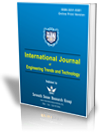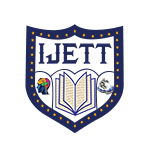Optimizing Quality of Service and Energy Efficiency in Hazardous Drone Ad-Hoc Networks (DANET) Using Kingfisher Routing Protocol (KRP)
Optimizing Quality of Service and Energy Efficiency in Hazardous Drone Ad-Hoc Networks (DANET) Using Kingfisher Routing Protocol (KRP) |
||
 |
 |
|
| © 2025 by IJETT Journal | ||
| Volume-73 Issue-1 |
||
| Year of Publication : 2025 | ||
| Author : J. Ramkumar, V. Valarmathi, R. Karthikeyan |
||
| DOI : 10.14445/22315381/IJETT-V73I1P135 | ||
How to Cite?
J. Ramkumar, V. Valarmathi, R. Karthikeyan, "Optimizing Quality of Service and Energy Efficiency in Hazardous Drone Ad-Hoc Networks (DANET) Using Kingfisher Routing Protocol (KRP) ," International Journal of Engineering Trends and Technology, vol. 73, no. 1, pp. 410-430, 2025. Crossref, https://doi.org/10.14445/22315381/IJETT-V73I1P135
Abstract
Communication networks in hazardous environments present additional problems to problems already encountered in terrain and environment, often unpredictable and extreme. The time and reliability of data communication for critical operations become necessary. When traditional networks fail, there is a need for real-time communication, and this is exactly the utility of Drone Ad-hoc Networks (DANET). DANET is relevant in search and rescue, surveillance, and emergency response. Routing in DANET has particularly difficult characteristics in that continuous coverage and stable communication links are hard. On top of this, high drone mobility, frequent network topology changes, and scarce power resources make it difficult to realize reliable data transmission with low power consumption simultaneously. To address them, presenting the Kingfisher Routing Protocol (KRP). The network modifies paths over time according to real-time conditions. This is a dynamic problem. Based on continuously monitored position, signal strength, and network density, the protocol dynamically reconfigures routes that maximize energy efficiency while providing Quality of Service (QoS). KRP uses advanced algorithms based on the behavior of kingfishers that maximize efficiency by making drones pick the best routes (load balancing and energy efficiency, respectively). Link failures can be detected, and recovery can be made robust through the protocol incorporation of pre- and post-mechanisms that handle them. Simulation shows that KRP achieves significant performance improvement (critical performance indicators: packet delivery ratio, latency, energy efficiency, and link stability). The enhancement of these outlines KRP's capability to enhance DANET activities within harsh environments, providing dependable and energy-efficient communication.
Keywords
Drones, Ad-hoc Networks, Disaster Management, Energy Efficiency, Routing Protocol, Kingfisher Routing Protocol.
References
[1] Tiziana Calamoneri, Federico Corò, and Simona Mancini, “A Realistic Model to Support Rescue Operations After an Earthquake Via Uavs,” IEEE Access, vol. 10, pp. 6109-6125, 2022.
[CrossRef] [Google Scholar] [Publisher Link]
[2] Chetna Singhal, and Subhrajit Barick, “ECMS: Energy-Efficient Collaborative Multi-UAV Surveillance System for Inaccessible Regions,” IEEE Access, vol. 10, pp. 95876-95891, 2022.
[CrossRef] [Google Scholar] [Publisher Link]
[3] Dongwook Kim, Chang Seong Ko, and Ilkyeong Moon, “Coordinated Logistics with Trucks and Drones for Premium Delivery,” Transportmetrica A: Transport Science, pp. 1-29, 2023.
[CrossRef] [Google Scholar] [Publisher Link]
[4] Kun Shen et al., “Multidepot Drone Path Planning with Collision Avoidance,” IEEE Internet of Things Journal, vol. 9, no. 17, pp. 16297-16307, 2022.
[CrossRef] [Google Scholar] [Publisher Link]
[5] Hailong Huang, and Andrey V. Savkin, “Deployment of Charging Stations for Drone Delivery Assisted by Public Transportation Vehicles,” IEEE Transactions on Intelligent Transportation Systems, vol. 23, no. 9, pp. 15043-15054, 2022.
[CrossRef] [Google Scholar] [Publisher Link]
[6] Sriveni Namani, and Bilal Gonen, “Smart Agriculture Based on IoT and Cloud Computing,” 2020 3rd International Conference on Information and Computer Technologies (ICICT), San Jose, CA, USA, pp. 553-556, 2020.
[CrossRef] [Google Scholar] [Publisher Link]
[7] Rukaiya Rukaiya et al., “Communication Architecture and Operations for SDR-Enabled Uavs Network in Disaster-Stressed Areas,” Ad Hoc Networks, vol. 160, 2024.
[CrossRef] [Google Scholar] [Publisher Link]
[8] Jaden Clark, Kunal Shah, and Mac Schwager, “Online Path Repair: Adapting to Robot Failures in Multi-Robot Aerial Surveys,” IEEE Robotics and Automation Letters, vol. 9, no. 3, pp. 2319-2326, 2024.
[CrossRef] [Google Scholar] [Publisher Link]
[9] Min Zhang et al., “Adaptive Routing Design for Flying Ad Hoc Networks,” IEEE Communications Letters, vol. 26, no. 6, pp. 1438-1442, 2022.
[CrossRef] [Google Scholar] [Publisher Link]
[10] Young Hoo Cho et al., “Multi-Criteria Coordinated Electric Vehicle-Drone Hybrid Delivery Service Planning,” IEEE Transactions on Vehicular Technology, vol. 72, no. 5, pp. 5892-5905, 2023.
[CrossRef] [Google Scholar] [Publisher Link]
[11] Huan Liu et al., “An Iterative Two-Phase Optimization Method for Heterogeneous Multi-Drone Routing Problem Considering Differentiated Demands,” Complex and Intelligent Systems, vol. 10, no. 5, pp. 6449-6466, 2024.
[CrossRef] [Google Scholar] [Publisher Link]
[12] K. A. Athira et al., “ACO-DTSP Algorithm: Optimizing UAV Swarm Routes with Workload Constraints,” Procedia Computer Science, vol. 235, pp. 163-172, 2024.
[CrossRef] [Google Scholar] [Publisher Link]
[13] Panupong Vichitkunakorn et al., “Locating Charging Stations and Routing Drones for Efficient Automated Stocktaking,” European Journal of Operational Research, vol. 316, no. 3, pp. 1129-1145, 2024.
[CrossRef] [Google Scholar] [Publisher Link]
[14] Mohsen Roytvand Ghiasvand, Donya Rahmani, and Mohammad Moshref-Javadi, “Data-Driven Robust Optimization for A Multi-Trip Truck-Drone Routing Problem,” Expert Systems with Applications, vol. 241, 2024.
[CrossRef] [Google Scholar] [Publisher Link]
[15] Rashid Alyassi et al., “Autonomous Recharging and Flight Mission Planning for Battery-Operated Autonomous Drones,” IEEE Transactions on Automation Science and Engineering, vol. 20, no. 2, pp. 1034-1046, 2023.
[CrossRef] [Google Scholar] [Publisher Link]
[16] Nameer Hashim Qasim, and Aqeel Mahmood Jawad, “5G-Enabled UAVs for Energy-Efficient Opportunistic Networking,” Heliyon, vol. 10, no. 12, pp. 1-18, 2024.
[CrossRef] [Google Scholar] [Publisher Link]
[17] Ahmed M. Khedr, and P. V. Pravija Raj, “A Hybrid MGO-JAYA Based Clustered Routing for FANETs,” Vehicular Communications, vol. 45, 2024.
[CrossRef] [Google Scholar] [Publisher Link]
[18] Qizhang Luo et al., “Multi-Objective Optimization Algorithm with Adaptive Resource Allocation for Truck-Drone Collaborative Delivery and Pick-Up Services,” IEEE Transactions on Intelligent Transportation Systems, vol. 24, no. 9, pp. 9642-9657, 2023.
[CrossRef] [Google Scholar] [Publisher Link]
[19] Sanaz Khalaj Rahimi, and Donya Rahmani, “A Hybrid Multi-Objective Solution Approach for A Reliable Truck-Drone Routing Problem Integrated with Pickup and Delivery Services,” Transportation Letters, pp. 1-19, 2024.
[CrossRef] [Google Scholar] [Publisher Link]
[20] M. Usha et al., “SWEEPER: Secure Waterfall Energy-Efficient Protocol-Enabled Routing in FANET,” IETE Journal of Research, vol. 70. no. 6, pp. 5784-5798, 2024.
[CrossRef] [Google Scholar] [Publisher Link]
[21] Khadija Abdulsattar, Youssef Harrath, and Jihene Kaabi, “Ant Colony Algorithm to Solve a Drone Routing Problem for Hazardous Waste Collection,” Arab Journal of Basic and Applied Sciences, vol. 30, no. 1, pp. 636-649, 2023.
[CrossRef] [Google Scholar] [Publisher Link]
[22] C. E. Perkins and E. M. Royer, “Ad hoc On-Demand Distance Vector (AODV) Routing,” Proceedings WMCSA'99. Second IEEE Workshop on Mobile Computing Systems and Applications, New Orleans, LA, USA, pp. 90-100, 1999.
[CrossRef] [Google Scholar] [Publisher Link]
[23] Mehdi Hosseinzadeh et al., “A Q-Learning-Based Smart Clustering Routing Method in Flying Ad Hoc Networks,” Journal of King Saud University - Computer and Information Sciences, vol. 36, no. 1, pp. 1-20, 2024.
[CrossRef] [Google Scholar] [Publisher Link]

